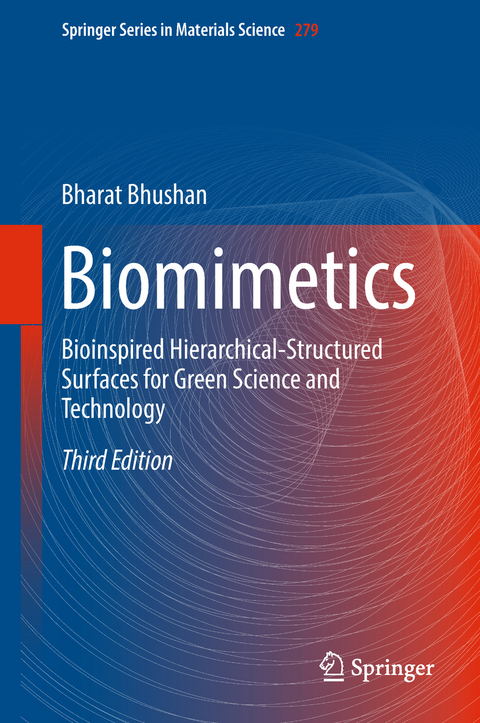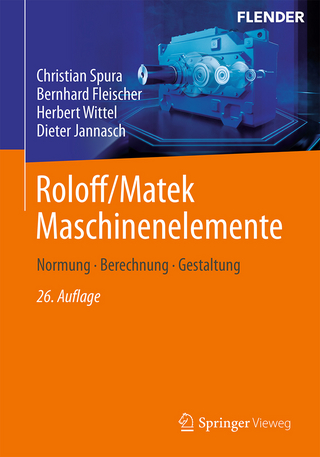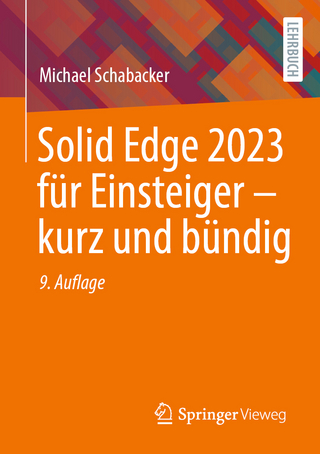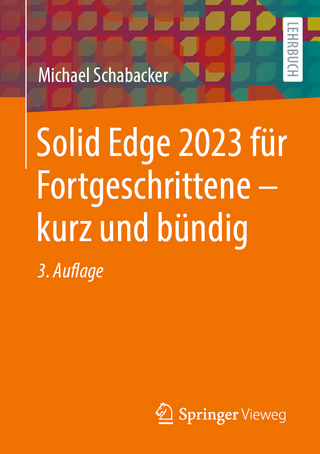
Biomimetics
Springer International Publishing (Verlag)
978-3-319-71675-6 (ISBN)
Dr. Bharat Bhushan is an Ohio Eminent Scholar and The Howard D. Winbigler Professor in the College of Engineering, and the Director of the Nanoprobe Laboratory for Bio- & Nanotechnology and Biomimetics (NLB2) and affiliated faculty in John Glenn College of Public Affairs at the Ohio State University, Columbus, Ohio. In 2013-14, he served as an ASME/AAAS Science & Technology Policy Fellow, House Committee on Science, Space & Technology, United States Congress, Washington, DC. He holds two M.S., a Ph.D. in mechanical engineering/mechanics, an MBA, and two honorary and two semi-honorary doctorates. His research interests include fundamental studies with a focus on scanning probe techniques in the interdisciplinary areas of bio/nanotribology, bio/nanomechanics and bio/nanomaterials characterization and applications to bio/nanotechnology, and biomimetics. He has authored 8 scientific books, 90+ handbook chapters, 800+ scientific papers (h index-76+; ISI Highly Cited Researcher in Materials Science since 2007 and in Biology and Biochemistry since 2013; ISI Top 5% Cited Authors for Journals in Chemistry since 2011), and 60+ scientific reports. He has also edited 50+ books and holds 20 U.S. and foreign patents. He is co-editor of Springer NanoScience and Technology Series and Microsystem Technologies, and member of editorial board of PNAS. He has organized various international conferences and workshops. He is the recipient of numerous prestigious awards and international fellowships including the Alexander von Humboldt Research Prize for Senior Scientists, Max Planck Foundation Research Award for Outstanding Foreign Scientists, Fulbright Senior Scholar Award, Life Achievement Tribology Award, and Institution of Chemical Engineers (UK) Global Award. His research was listed as the top ten science stories of 2015. He is a member of various professional societies, including the International Academy of Engineering (Russia). He has previously worked for various research labs including IBM Almaden Research Center, San Jose, CA. He has held visiting professorship at University of California at Berkeley, University of Cambridge, UK, Technical University Vienna, Austria, University of Paris, Orsay, ETH Zurich, EPFL Lausanne, Univ. of Southampton, UK, Univ. of Kragujevac, Serbia, Tsinghua Univ., China, Harbin Inst., China, and KFUPM, Saudi Arabia.
lt;p>Chapter 1. Introduction (Revised)
1.1. Introduction
1.2. Biodiversity
1.3. Lessons from Nature
1.4. Golden Ratio and Fibonacci Numbers
1.5. Biomimetics in Art and Architecture - Bioarchitecture1.6. Industrial Significance
1.7. Research Objective and Approach
1.8. Organization of the Book
Chapter 2. Roughness-Induced Superliquiphilic/phobic Surfaces: Lessons from Nature (Revised)
2.1. Introduction2.2. Wetting States
2.3. Applications
2.4. Natural Superhydrophobic, Self-Cleaning, Low Adhesion/Drag Reduction Surfaces with Antifouling
2.5. Natural Superhydrophobic and High Adhesion Surfaces
2.6. Natural Superoleophobic Self-Cleaning and Low Drag Surfaces with Antifouling
2.7. Closure
Chapter 3. Modeling of Contact Angle for a Liquid in Contact with a Rough Surface for Various Wetting Regimes (Revised)
3.1. Introduction
3.2. Contact Angle Definition
3.3. Homogenous and Heterogeneous Interfaces and the Wenzel, Cassie-Baxter and Cassie Equations3.3.1. Limitations of the Wenzel and Cassie-Baxter Equations
3.3.2. Range of Applicability of the Wenzel and Cassie-Baxter Equations
3.4. Contact Angle Hysteresis
3.5. Stability of a Composite Interface and Role of Hierarchical Structure with Convex Surfaces
3.6. The Cassie-Baxter and Wenzel Wetting Regime Transition
3.7. Closure
Chapter 4. Lotus Effect Surfaces in Nature (Revised)
4.1. Introduction
4.2. Plant Leaves
4.3. Characterization of Superhydrophobic and Hydrophilic Leaf Surfaces
4.3.1. Experimental Techniques
4.32. SEM Micrographs
4.3.3. Contact Angle Measurements
4.3.4. Surface Characterization Using an Optical Profiler4.3.5. Surface Characterization, Adhesion, and Friction Using an AFM
4.3.6. Role of the Hierarchical Roughness
4.3.7. Summary
4.4. Various Self-cleaning Approaches
4.4.1. Comparison between Superhydrophobic and Superhydrophilic Surface Approaches for Self-cleaning
4.4.2. Summary
4.5. Closure
Chapter 5. Fabrication Techniques used for Superliquiphilic/phobic Structures (Revised)5.1. Introduction
5.2. Roughening to Create One-Level Structure
5.3. Coatings to Create One-Level Structures
5.4. Methods to Create Two-Level (Hierarchical) Structures
5.5. Etching Techniques for Attachment of Coatings
5.6. Closure
Chapter 6. Strategies of Micro-, Nano- and Hierarchically Structured Lotus-like Surfaces (Revised)
6.1. Introduction
6.2. Experimental Techniques
6.2.1. Contact Angle, Surface Roughness, and Adhesion
6.2.2. Droplet Evaporation Studies
6.2.3. Bouncing Droplet Studies6.2.4. Vibrating Droplet Studies
6.2.5. Microdroplet Condensation and Evaporation Studies using ESEM
6.2.6. Generation of Submicron Droplets
6.3. Micro- and Nanopatterned Polymers
6.3.1. Contact Angle
6.3.2. Effect of Submicron Droplet on Contact Angle
6.3.3. Adhesive Force
6.3.4. Summary
6.4. Micropatterned Si Surfaces
6.4.1. Cassie-Baxter and Wenzel Transition Criteria
6.4.2. Effect of Pitch Value on the Transition
6.4.3. Observation of Transition during the Droplet Evaporation
6.4.4. Another Cassie-Baxter and Wenzel Transition for Different Series
6.4.5. Contact Angle Hysteresis and Wetting/Dewetting Asymmetry
6.4.6. Contact Angle Measurements During Condensation and Evaporation of Microdroplets on Micropatterned Surfaces
6.4.7. Observation of Transition during the Bouncing Droplet
6.4.8. Summary
6.5. Ideal Surfaces with Hierarchical Structure
6.6. Hierarchically Structured Surfaces with Wax Platelets and Tubules using Nature's Route
6.6.1. Effect of Nanostructures with Various Wax Platelet Crystal Densities on Superhydrophobicity
6.6.2. Effect of Hierarchical Structure with Wax Platelets on the Superhydrophobicity
6.6.3. Effect of Hierarchical Structure with Wax Tubules on Superhydrophobicity
6.6.4. Self-Cleaning Efficiency of Hierarchically Structured Surfaces
6.6.5. Observation of Transition during the Bouncing Droplet
6.6.6. Observation of Transition during the Vibrating Droplet
6.6.7. Measurement of Fluid Drag Reduction
6.6.8. Summary
Chapter 7. Fabrication and Characterization of Mechanically Durable Superhydrophobic Surfaces (Revised)
7.1. Introduction
7.2. Experimental Techniques
7.2.1. Waterfall/Jet Tests
7.2.2. Wear and Friction Tests
7.2.3. Transmittance Measurements
7.3. CNT Composites
7.4. Nanoparticle Composites with Hierarchical Structure
7.5. Nanoparticle Composites for Optical Transparency
7.6. Deep Reactive Ion Etched Surfaces for Optical Transparency
7.7. Superhydrophobic Paper Surfaces
7.8. Closure
Chapter 8. Fabrication and Characterization of Micropatterned Structures Inspired by Salvinia Molesta
8.1. Introduction
8.2. Characterization of Leaves and Fabrication of Inspired Structural Surfaces
8.3. Measurement of Contact Angle and Adhesion
8.3.1. Observation of Pinning and Contact Angle
8.3.2. Adhesion
8.4. Closure
Chapter 9. Characterization of Rose Petals and Fabrication and Characterization of Superhydrophobic Surfaces with High and Low Adhesion
9.1. Introduction
9.2. Characterization of Two Kinds of Rose Petals and Their Underlying Mechanisms
9.3. Fabrication of Surfaces with High and Low Adhesion for Understanding of Rose Petal Effect
9.4. Fabrication of Mechanically Durable, Superhydrophobic Surfaces with High Adhesion
9.4.1. Samples with Hydrophilic ZnO Nanoparticles (Before ODP Modification)
9.4.2. Samples with Hydrophobic ZnO Nanoparticles (After ODP Modification)
9.4.3. Wear Resistance in AFM Wear Experiment
9.5. Closure
Chapter 10. Modeling and Strategies of Superoleophobic/philic Surfaces (Revised)
10.1. Introduction
10.2. Strategies to Achieve Superoleophobicity in Air
10.2.1. Fluorination Techniques
10.2.2. Re-entrant Geometry
10.3. Model to Predict Oleophobic/philic Nature of Surfaces
10.4. Validation of Oleophobicity/philicity Model for Oil Droplets in Air and Water10.4.1. Experimental Techniques
10.4.2. Fabrication of Oleophobic/philic Surfaces
10.4.3. Characterization of Oleophobic/philic Surfaces
10.4.4. SummaryChapter 11. Fabrication and Characterization of Superoleophilic/phobic Surfaces (Revised)
11.1. Introduction
11.2. Nanoparticle Composite Coatings for Superliquiphilicity/phobicity
11.2.1. Experimental Details
11.2.2. Results and Discussion
11.2.3. Summary11.3. Nanoparticle Composite Coatings for Superliquiphilicity and Superliquiphobicity Using Layer-by-Layer Technique
11.3.1. Experimental Details
11.3.2. Results and discussion
11.3.3. Summary
11.4. Superoleophobic Polymer Surfaces
11.4.1. Experimental Details
11.4.2. Results and Discussion
11.4.3. Summary11.5. Superoleophobic Aluminum Surfaces
11.2.1. Experimental Details
11.2.2. Results and Discussion
11.2.3. Summary
11.6. Closure
Chapter 12. Shark-Skin Surface for Fluid-Drag Reduction in Turbulent Flow (Revised)
12.1. Introduction
12.2. Fluid Drag Reduction
12.2.1. Mechanisms of Fluid Drag
12.2.2. Shark Skin
12.3. Fluid Flow Modeling
12.3.1. Riblet Geometry Models
12.3.2. Results and Discussion
12.3.3. Summary
12.4. Experimental Studies
12.4.1. Flow Visualization Studies
12.4.2. Riblet Geometries and Configurations
12.4.3. Riblet Fabrication
12.4.4. Riblet Scale-up Fabrication
12.4.5. Drag Measurement Techniques
12.4.6. Riblet Results and Discussion
12.4.7. Summary12.5. Application of Riblets for Drag Reduction and Antifouling
12.6. Closure
Chapter 13. Black Skimmer Surfaces for Fluid-Drag Reduction in Turbulent Flow (New)
13.1. Introduction
13.2. Fluid Flow Modeling
13.3. Experimental Studies
13.4. ClosureChapter 14. Rice Leaf and Butterfly Wing Effect
14.1. Introduction
14.2. Inspiration from Living Nature
14.2.1. Ambient Species - Lotus Effect
14.2.2. Aquatic Species - Shark Skin and Fish Scales Effect
14.2.3. Ambient Species - Rice Leaf and Butterfly Wing Effect
14.3. Sample Fabrication
14.3.1. Actual Sample Replicas
14.3.2. Rice Leaf Inspired Surfaces
14.4. Pressure Drop Measurement Technique
14.5. Results and Discussion
14.5.1. Surface Characterization
14.5.2. Pressure Drop Measurements
14.5.3. Wettability
14.5.4. Drag Reduction Models14.6. Closure
Chapter 15. Bio- and Inorganic Fouling (Revised)
15.1. Introduction
15.2. Fields Susceptible to Fouling
15.3. Biofouling and Inorganic Fouling Formation Mechanisms
15.3.1. Biofouling Formation
15.3.2. Inorganic Fouling Formation
15.3.3. Surface Factors
15.4. Antifouling Strategies from Living Nature
15.5. Antifouling: Current Prevention and Cleaning Techniques
15.5.1. Prevention Techniques15.5.2. Self-cleaning Surfaces and Cleaning Techniques
15.6. Bioinspired Rice Leaf Surfaces for Antifouling
15.6.1. Fabrication of Micropatterned Samples
15.6.2. Anti-biofouling Measurements
15.6.3. Anti-inorganic Fouling Measurements
15.6.4. Results and Discussion
15.6.5. Anti-biofouling and Anti-inorganic Fouling Mechanisms
15.7. Closure
Chapter 16. Gecko Adhesion
16.1. Introduction
16.2. Hairy Attachment Systems
16.3. Tokay Gecko16.3.1. Construction of Tokay Gecko
16.3.2. Adhesion Enhancement by Division of Contacts and Multilevel Hierarchical Structure
16.3.3. Peeling
16.3.4. Self-Cleaning
16.4. Attachment Mechanisms
16.4.1. van der Waals Forces
16.4.2. Capillary Forces
16.5. Adhesion Measurements and Data
16.5.1. Adhesion under Ambient Conditions
16.5.2. Effects of Temperature
16.5.3. Effects of Humidity
16.5.4. Effects of Hydrophobicity16.6. Adhesion Modeling of Fibrillar Structures
16.6.1. Single Spring Contact Analysis
16.6.2. The Multi-Level Hierarchical Spring Analysis
16.6.3. Adhesion Results of the Multi-level Hierarchical Spring Model
16.6.4. Capillary Effects
16.7. Adhesion Data Base of Fibrillar Structures
16.7.1. Fiber Model
16.7.2. Single Fiber Contact Analysis
16.7.3. Constraints
16.7.4. Numerical Simulation
16.7.5. Results and Discussion
16.8. Fabrication of Gecko Skin-Inspired Structures
16.8.1. Single Level Roughness Structures
16.8.2. Multi-Level Hierarchical Structures
16.9. Closure
Chapter 17. Structure and Mechanical Properties of Nacre
17.1. Introduction17.2. Hierarchical Structure
17.2.1. Columnar and Sheet Structure
17.2.2. Mineral Bridges
17.2.3. Polygonal Nanograins
17.2.4. Inter-tile Toughening Mechanism17.3. Mechanical Properties
17.4. Bioinspired Structures
17.5. Closure
Chapter 18. Structural Coloration
18.1. Introduction
18.2. Physical Mechanisms of Structural Colors18.2.1. Film Interference
18.2.2. Diffraction Gratings
18.2.3. Scattering
18.2.4. Photonic Crystals
18.2.5. Coloration Changes18.3. Lessons from Living Nature
18.3.1. Film interference
18.3.2. Diffraction Grating18.3.3. Scattering
18.3.4. Photonic Crystals
18.3.5. Coloration Changes18.4. Bioinspired Fabrication and Applications
18.5. ClosureChapter 19. Self-Healing Materials (NEW)
19.1 xxxxxx
19.2 xxxxxx
19.3 xxxxxx
Chapter 20. Structures for Water Harvesting
20.1 xxxxxx
20.2 xxxxxx
20.3 xxxxxx
Chapter 21. Outlook (Revised)
Appendix A. Gas Nanobubbles and Fluid Slip in Liquiphobic Surfaces
Subject Index (to be prepared by production staff)
Bio and Photograph of Author
| Erscheinungsdatum | 16.10.2018 |
|---|---|
| Reihe/Serie | Springer Series in Materials Science |
| Zusatzinfo | XXIX, 977 p. 523 illus., 301 illus. in color. |
| Verlagsort | Cham |
| Sprache | englisch |
| Maße | 155 x 235 mm |
| Gewicht | 1670 g |
| Themenwelt | Technik ► Maschinenbau |
| Schlagworte | Biomimetics inspired surfaces • Butterfly wing effect • Characterization of rose petals • gecko feet • Green science and technology • Hierarchical structures surfaces • Lotus effect • Properties of Nacre and structural coloration • self-cleaning • Shark Skin Effect • Superhydrophobic Surfaces • Superoleophobicity self cleaning • Superomniphobic surfaces |
| ISBN-10 | 3-319-71675-1 / 3319716751 |
| ISBN-13 | 978-3-319-71675-6 / 9783319716756 |
| Zustand | Neuware |
| Informationen gemäß Produktsicherheitsverordnung (GPSR) | |
| Haben Sie eine Frage zum Produkt? |
aus dem Bereich


